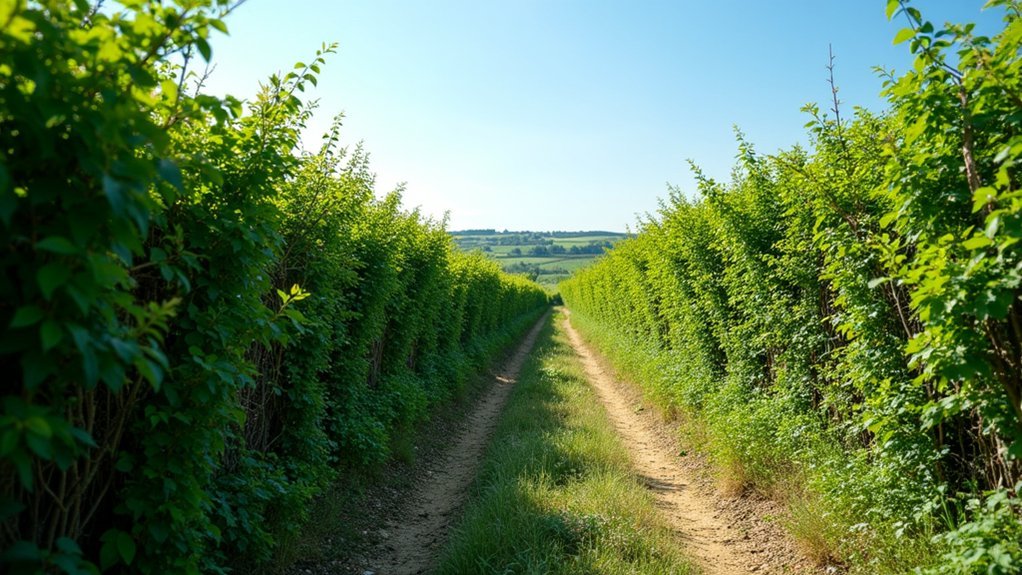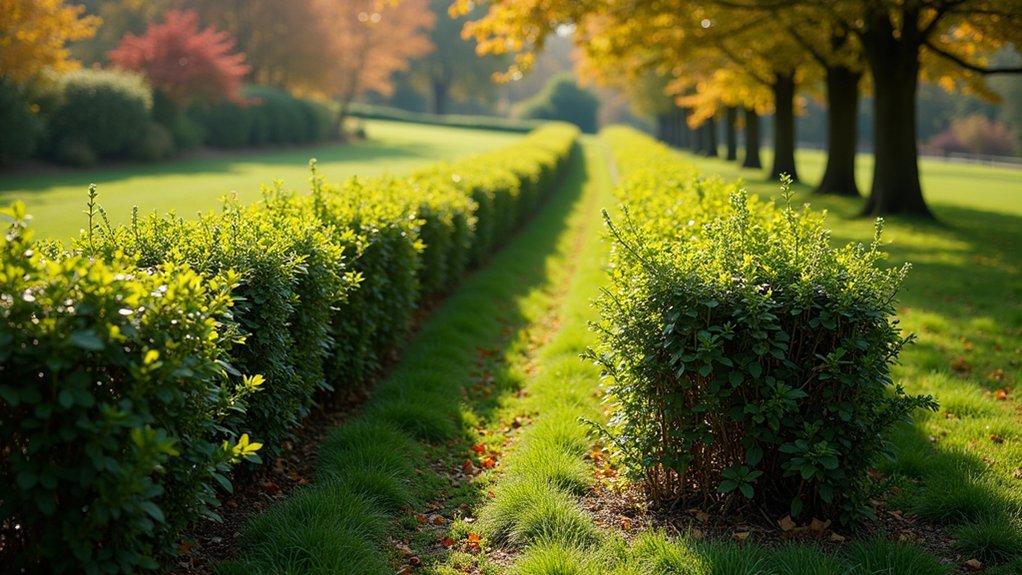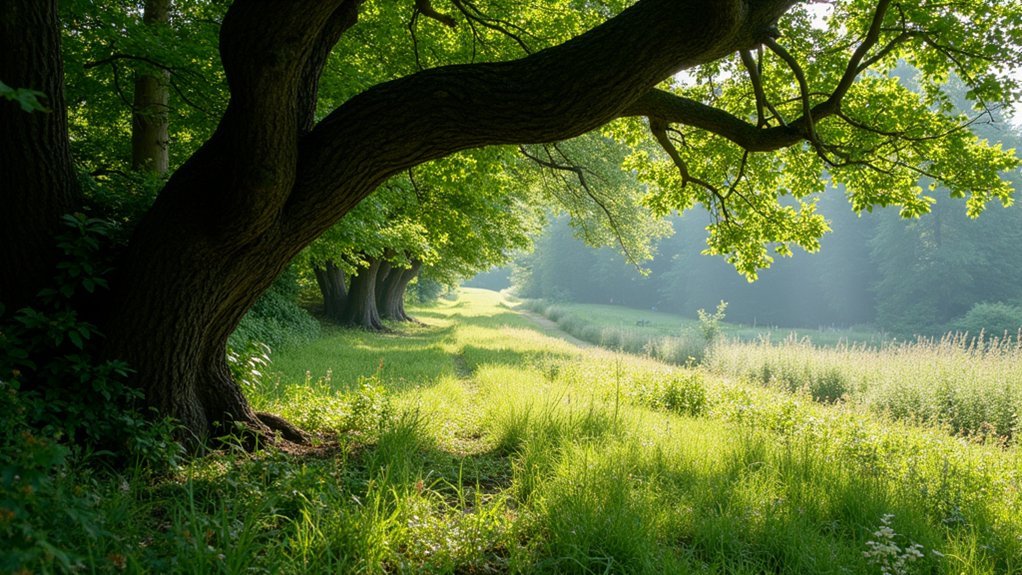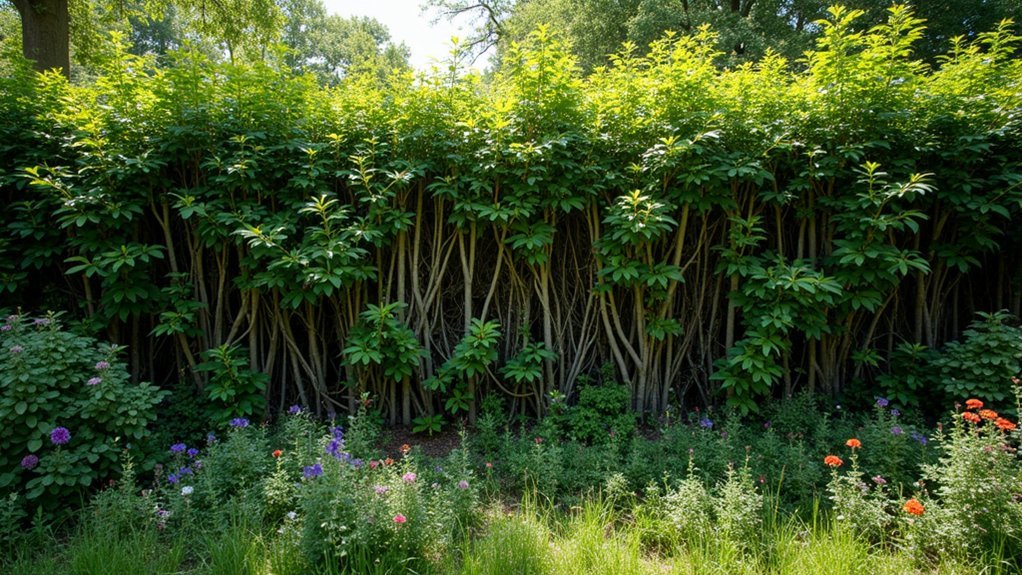Hedge laying is essential for conservation because it transforms sparse hedgerows into dense wildlife corridors that support over 149 invertebrate species. You’ll preserve both cultural heritage and create crucial habitat connectivity when you practice this traditional technique. Unlike modern trimming, proper laying maintains root systems while developing thick, impenetrable growth that allows animals to travel safely between fragmented habitats. With only 2% of UK hedges properly rejuvenated today, your involvement helps restore critical ecological balance across the landscape.
The Rich History of British Hedgerows

While modern fencing dominates today’s landscape, British hedgerows stand as living monuments to centuries of rural craftsmanship. Before barbed wire transformed farming practices, hedge laying was essential for creating effective livestock barriers across the countryside.
Once essential barriers for livestock, British hedgerows remain living testaments to rural ingenuity and craftsmanship.
You’ll find these living boundaries vary distinctly by region, with styles like Midland and Dorset each reflecting the unique character of their traditional country origins.
As evidenced in a 1942 film, this agricultural art was once commonplace, performed by skilled workers using time-honored tools.
The cultural significance of these hedgerows extends beyond their practical purpose. They embody generations of knowledge passed through rural communities.
Today, the National Hedge Laying Society leads revival efforts, ensuring this important craft continues to connect younger generations with their agricultural heritage.
Understanding the Ecological Value of Hedgerows
Hedgerows form essential wildlife corridor networks, allowing species like dormice and bank voles to travel safely between larger habitats while avoiding predators.
You’ll find these living boundaries act as biodiversity hubs, supporting an impressive 149+ invertebrate species on native plants such as hawthorn alone.
When you maintain hedgerows properly through techniques like laying and coppicing, you’re preserving important ecological connections that help combat habitat fragmentation across the British countryside.
Wildlife Corridor Networks
The intricate web of hedgerows crisscrossing our countryside serves a purpose far beyond mere field boundaries. They’re crucial wildlife corridors enabling species to move between isolated habitat patches, enhancing genetic diversity and population resilience.
When you lay hedges properly, you’re creating denser vegetation that supports more wildlife habitat. These corridors become highways for small mammals, birds, and invertebrates that wouldn’t cross open fields.
| Hedgerow Type | Wildlife Support | Corridor Effectiveness |
|---|---|---|
| Dense, laid | Excellent | High connectivity |
| Gappy, sparse | Limited | Poor connectivity |
| Rejuvenated | Improving | Restoring networks |
You’ll find that agri-environment schemes supporting hedge laying are essential for maintaining these networks. Without them, habitat fragmentation would isolate populations, reducing biodiversity and ecological resilience across agricultural landscapes.
Biodiversity Habitat Hubs
Far beyond simply dividing farmland, properly laid hedgerows function as vibrant biodiversity hubs that sustain entire ecosystems within agricultural landscapes.
You’ll find these living boundaries support over 149 invertebrate species on common plants like hawthorn alone, while creating habitat essential for threatened wildlife such as dormice and cirl buntings.
When you maintain hedgerows through traditional laying techniques, you’re developing dense woody structures that connect fragmented landscapes, allowing species to move and thrive.
These biodiversity habitat hubs provide critical resources throughout the year—spring blossoms for pollinators and autumn berries for birds and mammals.
Research confirms that well-laid hedges host considerably greater invertebrate diversity than unmanaged ones.
How Hedge Laying Strengthens Wildlife Corridors

Essential to maintaining biodiversity across rural landscapes, properly laid hedges create important highways for wildlife. When you lay hedges correctly, you’re establishing dense hedge networks that connect fragmented habitats, allowing species to move freely and exchange genetic material.
| Wildlife Benefit | How Laid Hedges Help |
|---|---|
| Movement | Prevents gaps that block travel routes |
| Shelter | Creates thicker barriers against predators |
| Foraging | Promotes diverse native plant growth |
| Reproduction | Supports nesting sites and materials |
| Genetic Diversity | Connects isolated populations |
You’ll find that these wildlife corridors are particularly important for smaller creatures like bank voles and hedgehogs that rely on continuous cover for protection. By maintaining these interconnected dense hedge systems, you’re supporting entire ecosystems while preserving the ecological functionality of your countryside.
Regional Styles and Their Conservation Impact
You’ll notice striking differences between the Yorkshire style’s low, dense hedges perfect for sheep habitat and the Midland style’s robust structures designed to contain bulls.
These regional techniques aren’t just cultural traditions—they’re precision-crafted approaches that maximize ecological benefits for specific wildlife communities.
Yorkshire vs. Midland
While both contribute considerably to Britain’s environmental heritage, the Yorkshire and Midland styles of hedge laying represent distinctly different approaches with unique conservation benefits.
The Yorkshire style creates low, dense hedges that excel at containing sheep while providing essential wildlife habitat. You’ll notice how this regional style forms protective barriers that offer both shelter and food sources for various species.
Meanwhile, the Midland technique employs distinctive vertical stakes with strong bindings, making it ideal for securing bulls and larger livestock.
Though different in form, both styles effectively combat hedge deterioration by preventing gapping and thinning. Each approach preserves native plant species that support diverse wildlife populations.
Habitat-Specific Techniques
Beyond the Yorkshire and Midland methods, Britain’s countryside showcases over 30 distinct regional hedgelaying styles, each carefully adapted to local conditions and conservation priorities. When you’re selecting a hedgelaying technique, you’ll need to evaluate how it supports local wildlife habitat and addresses specific environmental challenges.
| Style | Region | Habitat Benefit | Conservation Impact |
|---|---|---|---|
| Yorkshire | Northern England | Low, dense shelter for sheep | Supports diverse plant structure |
| Midland | Central England | Strong barriers for cattle | Promotes ecological stability |
| Devon | Southwest | Riverbank protection | Preserves unique species |
| Regional | Various | Wildlife corridors | Maintains habitat connectivity |
These traditional techniques have been passed down through generations, ensuring that hedgelaying continues to provide essential wildlife habitats while meeting agricultural needs. Each style’s unique approach maximizes its effectiveness in specific local ecosystems.
Seasonal Timing: When to Perform Hedge Laying

Choosing the correct time of year for hedge laying is essential to the health and conservation value of the hedge. You’ll want to work during winter months when sap isn’t flowing, ensuring trees remain alive while being laid down. A properly laid hedge maintains its root connection while creating a living barrier.
You must complete all work by the end of March to protect nesting birds from habitat disruption during their breeding season. Nature provides its own calendar—when blackthorn begins to bloom, it’s time to put your billhook away.
Remember that hedge management operates on a long-term cycle, with rejuvenation needed every five to 50 years depending on condition.
Don’t forget to install protective fencing around your newly laid hedge to prevent deer browsing during vulnerable regrowth periods.
The Decline of Traditional Hedgerow Management
Despite their ecological importance, traditional hedgerows face a troubling decline across the UK landscape. You’ve likely noticed these changes—over a decade (1997-2007), the UK lost 6.2% of its hedgerow length, primarily due to poor management practices.
| Time Period | Hedgerow Status | Wildlife Impact |
|---|---|---|
| Pre-1997 | Well-maintained | Strong habitats for mammals |
| 2007 | 48% in good condition | Declining bank vole populations |
| Current | Only 2% properly rejuvenated | Fragmented wildlife corridors |
The scarcity of traditional hedgerow plant management techniques like laying and coppicing has led to sparse, gappy structures. When managing hedges, you’re not just maintaining boundaries but preserving critical wildlife corridors. Without intervention, these gaps notably reduce habitat quality for small mammals and other species dependent on continuous hedgerow networks.
Techniques for Effective Hedge Rejuvenation

You’ll find ancient hedge cutting methods provide superior habitat benefits compared to mechanical approaches, as traditional techniques like hedge laying and coppicing stimulate denser regrowth at the base.
Timing your rejuvenation work correctly is essential—winter months (November to March) offer the ideal window when birds aren’t nesting and plants are dormant.
These seasonal considerations not only comply with wildlife protection laws but also maximize the hedge’s recovery potential, ensuring stronger regrowth when spring arrives.
Ancient Cutting Methods
While modern mechanized flailing has become commonplace, traditional hedge laying techniques dating back centuries provide superior ecological benefits and structural integrity.
These ancient methods follow a 40-year management cycle that maintains hedge density and health.
The cornerstone technique is pleaching—partially cutting young stems at steep angles before laying them horizontally while keeping them alive. This strategic cutting stimulates new growth at the base, creating denser, more resilient hedgerows.
Coppicing complements this approach by cutting stems near ground level, encouraging vigorous regrowth and enhancing biodiversity.
You’ll find these time-tested practices deliver measurable conservation benefits. Research confirms traditionally rejuvenated hedges support greater invertebrate diversity and plant species richness than unmanaged alternatives.
Despite these advantages, only 2% of hedges currently receive this valuable traditional management.
Seasonal Work Timing
For conservation-minded hedge restoration, timing is everything.
You’ll need to schedule your hedge laying during winter months before March ends, when trees remain dormant and birds haven’t yet begun to lay their eggs. This vital seasonal timing prevents disturbance to nesting wildlife while maximizing the hedge’s ability to recover.
Traditional techniques involve cutting stems at steep angles and bending them while keeping the plant alive. This stimulates healthier regrowth and creates more robust habitats.
You should plan your maintenance cycle carefully—hedges typically need laying every 5 to 50 years, depending on growth rates and your conservation goals.
Consider incorporating coppicing methods by cutting selected stems near ground level to encourage fresh growth.
When you follow proper seasonal timing, you’ll create hedge systems that greatly enhance biodiversity and wildlife shelter.
Benefits for Ground-Nesting Birds and Small Mammals
Sanctuary beneath the woven branches awaits vulnerable wildlife when hedgerows undergo traditional laying techniques.
When you lay hedges properly, you’re creating dense, low structures that shield ground-nesting birds from corvids and other aerial predators that would otherwise spot them easily.
The renewed growth at the base of laid hedges encourages diverse plant communities that provide both shelter and sustenance for small mammals like bank voles and hedgehogs.
You’ll notice these animals thriving as they utilize the improved habitat for nesting materials and foraging opportunities.
Well-maintained hedgerows also serve as wildlife corridors, allowing small mammals to travel safely between habitats.
This movement supports genetic diversity and strengthens fragile populations.
Creating Microhabitats Through Structural Diversity

When properly laid, hedgerows transform into ecological tapestries of microhabitats, each supporting distinct communities of wildlife.
You’ll find that the varied structure creates different temperature gradients, moisture levels, and light conditions throughout the hedge.
This structural diversity encourages a range of plant species to thrive, which in turn supports over 149 invertebrate species.
The dense, layered vegetation you create through laying provides essential nesting sites, protective cover, and food sources all in one linear feature.
Hedge laying crafts living sanctuaries where wildlife finds shelter, safety, and sustenance within intricate leafy corridors.
As you maintain your hedges through traditional laying techniques, you’re enhancing their ability to serve as wildlife corridors, connecting otherwise isolated habitats.
The increased biomass and varied architecture allow different species to find their niche, from ground-dwelling mammals to canopy-dwelling insects, all within a few meters of space.
Comparing Hedge Laying to Modern Trimming Methods
Although both techniques manage hedge growth, traditional hedge laying considerably outperforms modern mechanical trimming in almost every ecological metric.
When you choose hedgelaying, you’re supporting a practice that creates thicker, denser structures that maintain their integrity for decades, operating on a 40-year rejuvenation cycle.
Modern trimming, while quick and convenient, leads to hollow, weakened hedges that develop gaps and sparse sections over time.
Research confirms this decline, with only 48% of UK hedges in ‘good condition’ by 2007.
The ecological differences are significant—hedgelaying promotes new growth and supports greater biodiversity of both plants and invertebrates, creating valuable wildlife habitats.
Unlike the structured approach of traditional methods, modern trimming lacks a systematic strategy for maintaining hedgerow health and robustness over the long term.
Supporting Pollinators and Berry Production
Traditional hedge laying creates ecological powerhouses that serve as lifelines for pollinators and berry-producing plants throughout the seasons.
The ancient art of hedge laying transforms ordinary boundaries into vibrant wildlife corridors that nourish ecosystems year-round.
When you lay hedges properly, you’re encouraging native hedgerow plants to thrive, providing essential nectar and pollen sources for bees and butterflies during their active months.
The dense structure you’ll achieve through hedge laying greatly improves habitat conditions for berry-producing species.
These berries aren’t just decorative—they’re vital winter food resources for birds and small mammals when other options disappear.
Research confirms that rejuvenated hedges produce more berries than their unmanaged counterparts, directly supporting wildlife during harsh winter periods.
Landscape Connectivity: Beyond Individual Hedges
While individual hedgerows provide essential habitat for local wildlife, their true conservation value emerges through their interconnected network across landscapes.
When you maintain hedgerows through proper laying techniques, you’re not just preserving isolated habitats—you’re creating significant wildlife corridors that enable species to move freely between fragmented environments.
Well-laid hedges with fewer gaps provide continuous pathways for small mammals, birds, and insects, allowing them to find food, mates, and new territories.
This landscape connectivity becomes increasingly important as habitat loss threatens biodiversity. The dense structure of traditionally laid hedges enhances this connectivity function, supporting more diverse species populations.
Learning the Craft: Preserving Traditional Skills
As the winter landscape falls dormant, hedge layers across Britain pick up their billhooks to practice a craft that’s endured for centuries.
You’ll find over 30 regional styles across the UK, each an important part of our agricultural heritage adapted to local conditions and needs.
If you’re interested in learning this traditional skill, consider:
- Joining volunteer groups at conservation sites like Lunt Meadows where you’ll gain hands-on experience while protecting wildlife
- Connecting with the National Hedge Laying Society (NHLS) which promotes the craft through championships and training
- Participating in local educational initiatives that welcome beginners and help preserve this vanishing rural knowledge
The revival of hedge laying guarantees these techniques aren’t lost to time, maintaining a crucial connection between contemporary conservation and traditional land management.
Frequently Asked Questions
What Are the Benefits of Hedge Laying?
You’ll boost biodiversity when you lay hedges. They’ll create denser barriers, promote new growth, provide better wildlife habitats, increase food sources, enhance ecological diversity, and restore essential wildlife corridors across landscapes.
Why Are Hedges Important?
Hedges are important because they’re wildlife havens where you’ll find diverse species thriving. They connect fragmented habitats, protect your livestock, and support ecological balance with native plants hosting countless invertebrates essential to Britain’s biodiversity.
What Is the History of Hedge Laying?
You’ll find hedge laying dates back centuries as a farming practice. It’s rooted in traditional stock management, with regional styles like Midland and Dorset emerging from local needs before barbed wire existed.
What Is the Significance of the Hedgerow?
Hedgerows serve as crucial habitats for diverse wildlife like hedgehogs and birds. You’ll find they’re essential ecological corridors that connect fragmented landscapes, provide food sources, and enhance biodiversity in rural Britain’s ecosystem.
In Summary
By taking up hedge laying, you’re not just preserving a traditional craft—you’re actively strengthening Britain’s ecological network. Your efforts create denser, healthier wildlife corridors that connect fragmented habitats. When you lay a hedge properly, you’ll protect countless species while maintaining our distinctive regional landscapes. As modern farming practices continue to change, your commitment to this ancient technique isn’t just beneficial—it’s essential for conservation’s future.





Leave a Reply